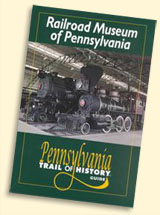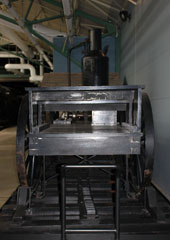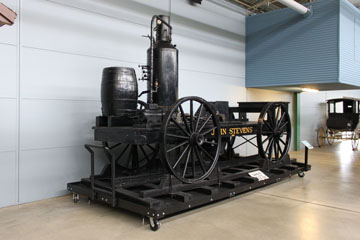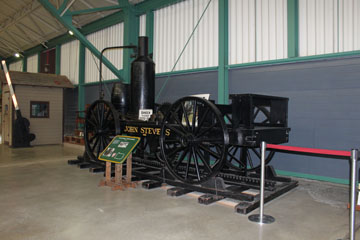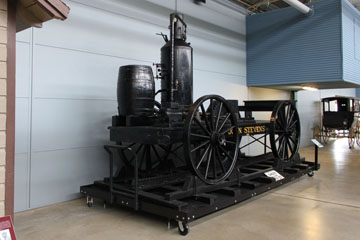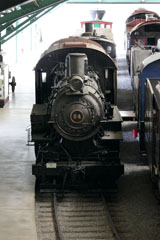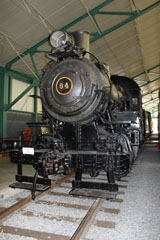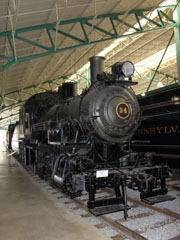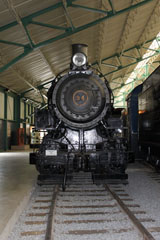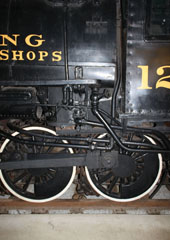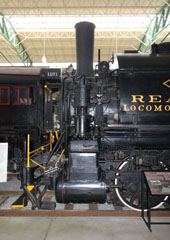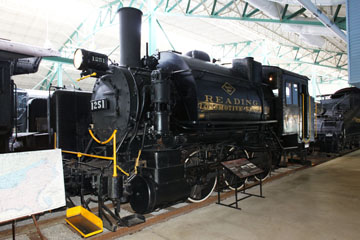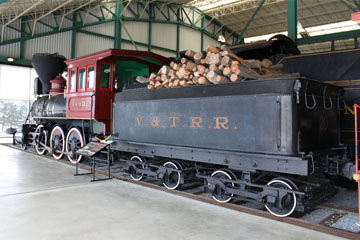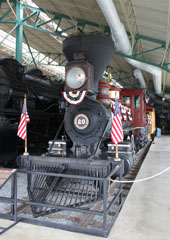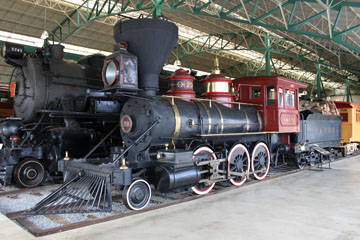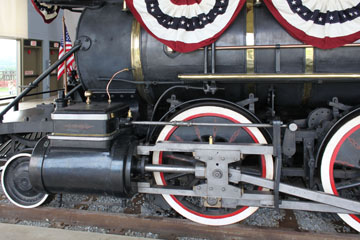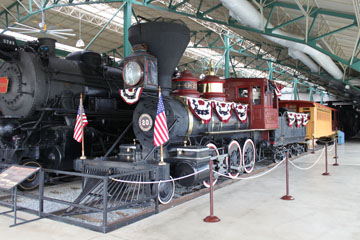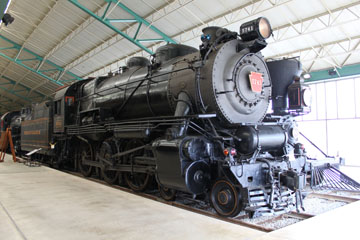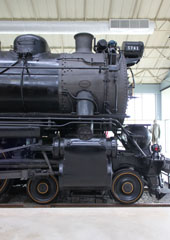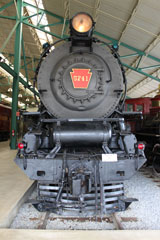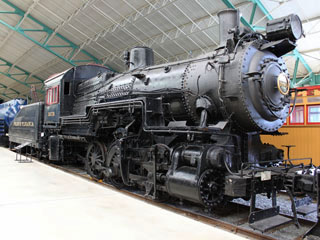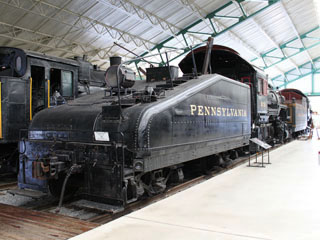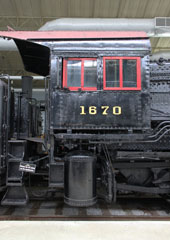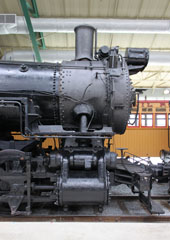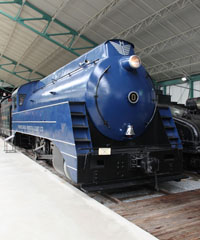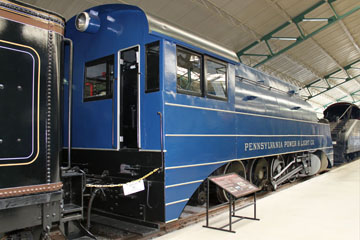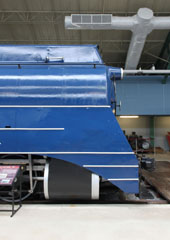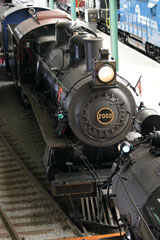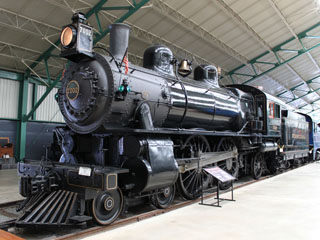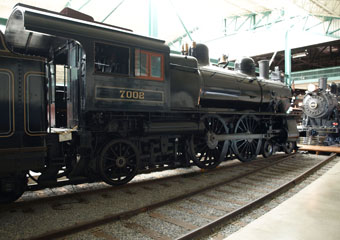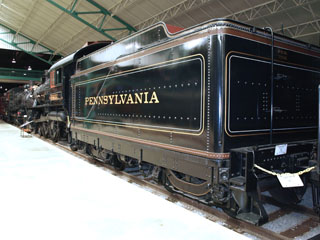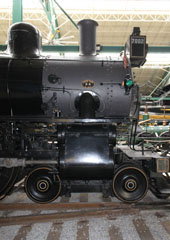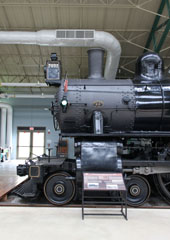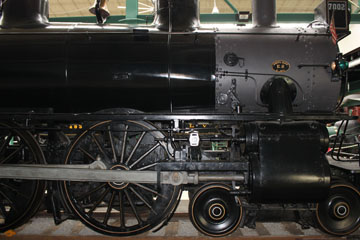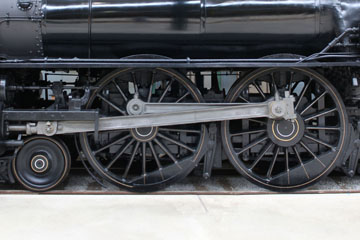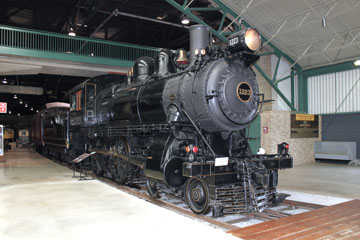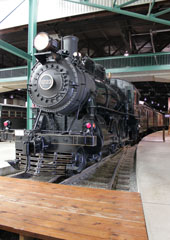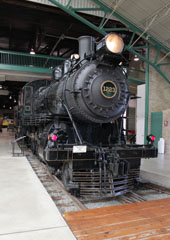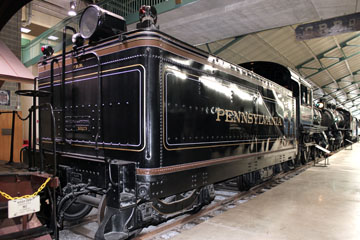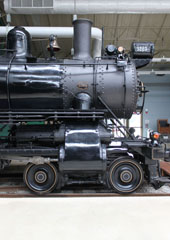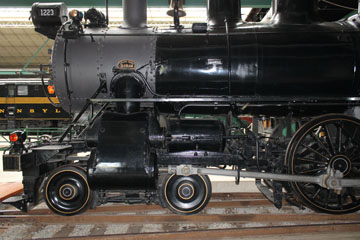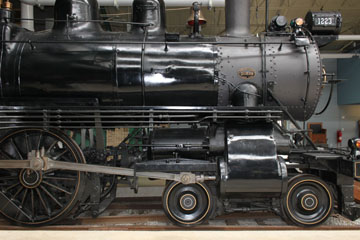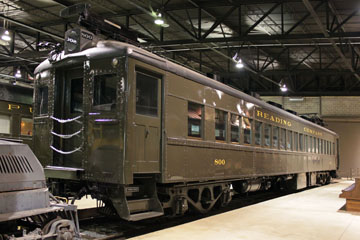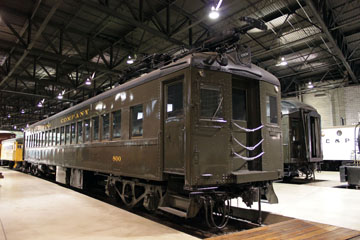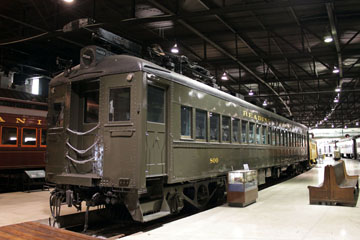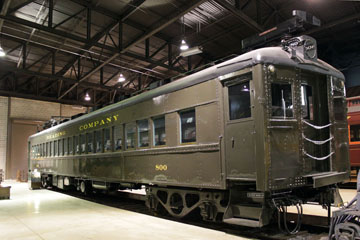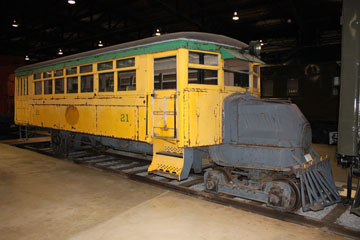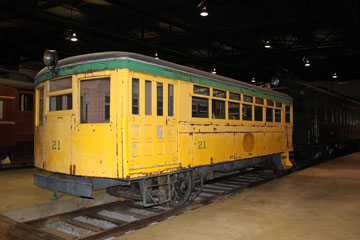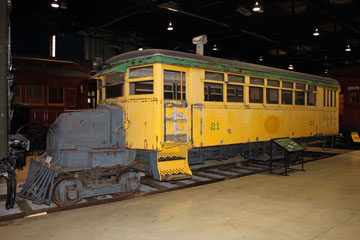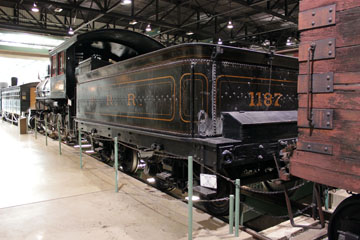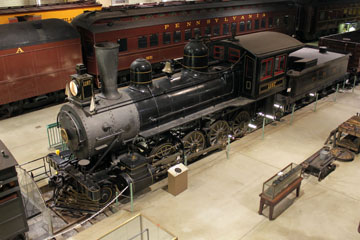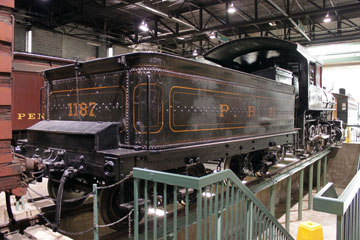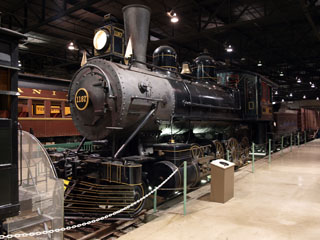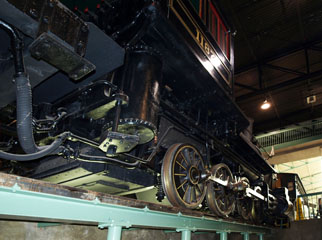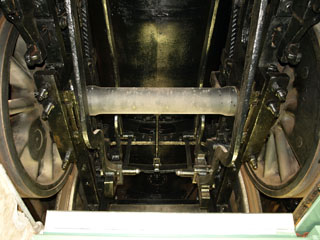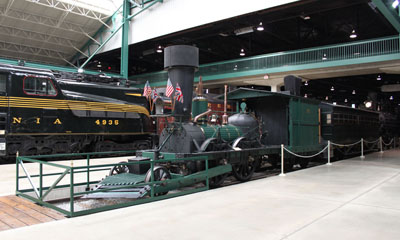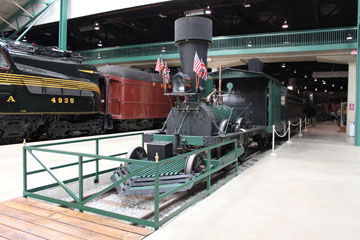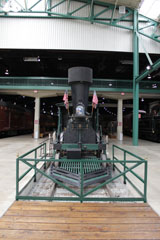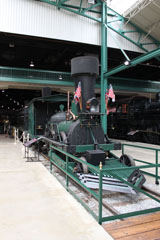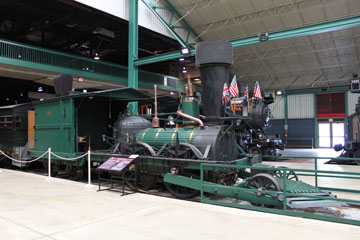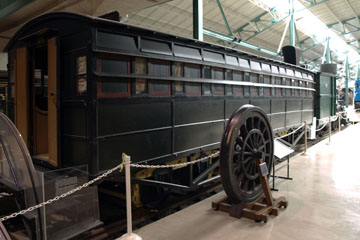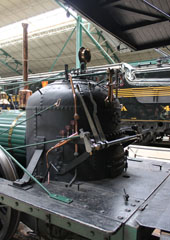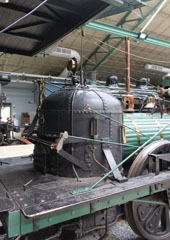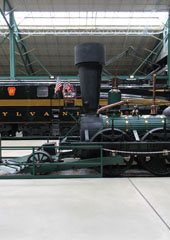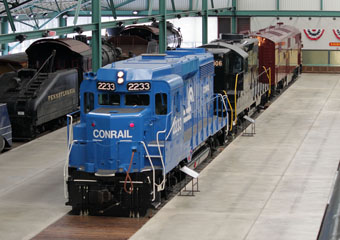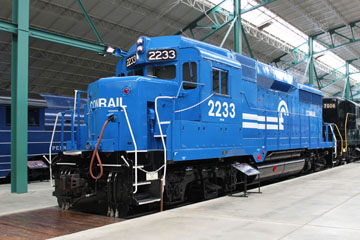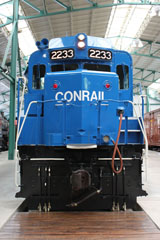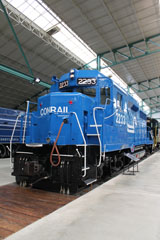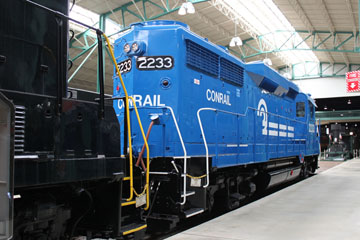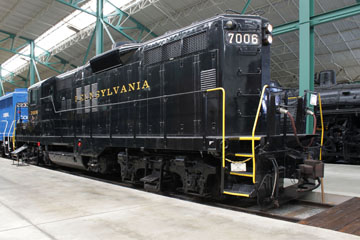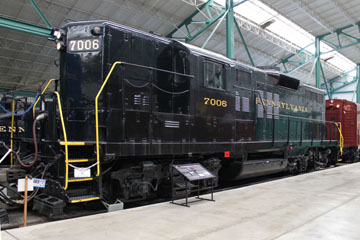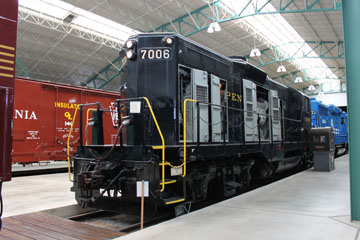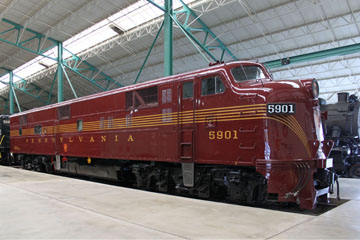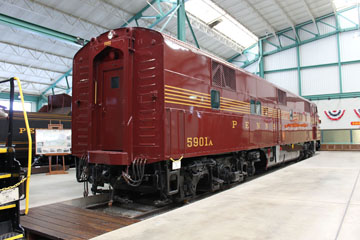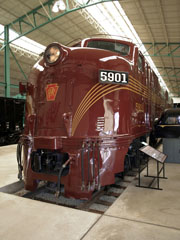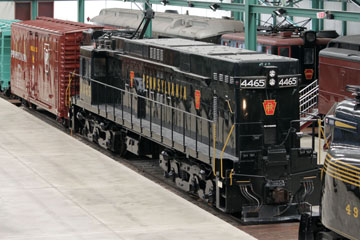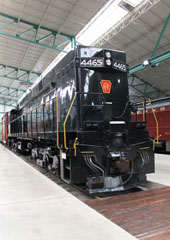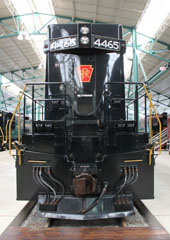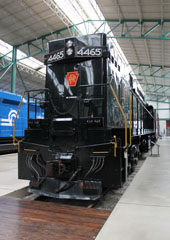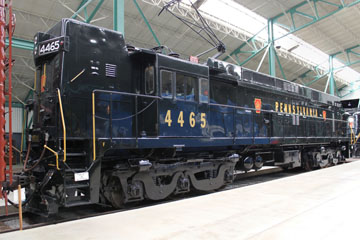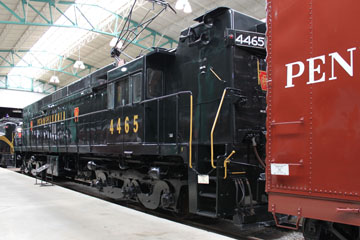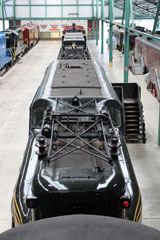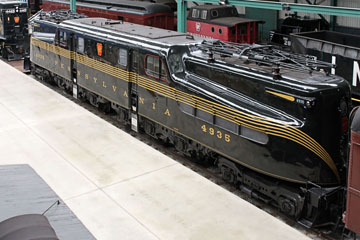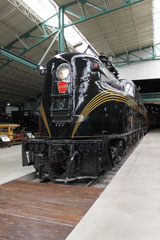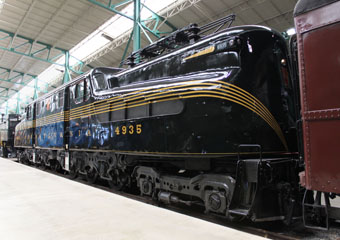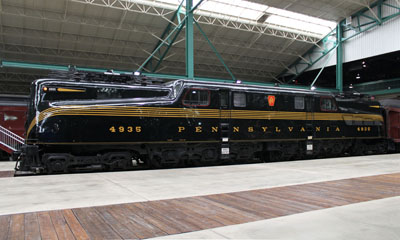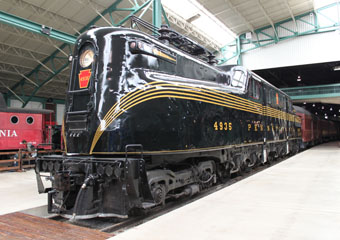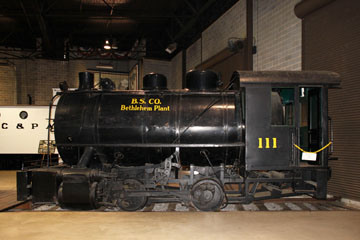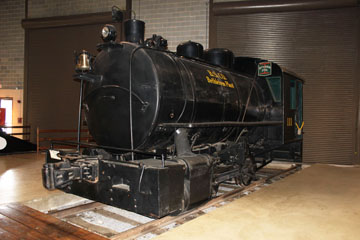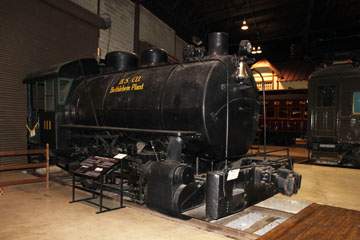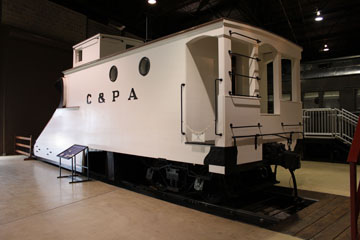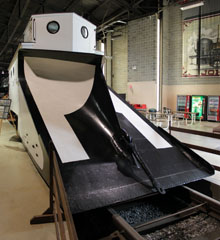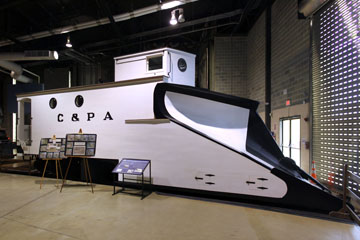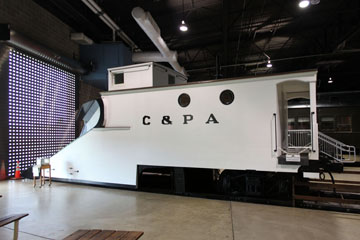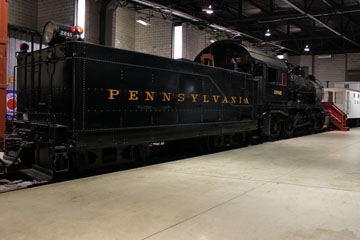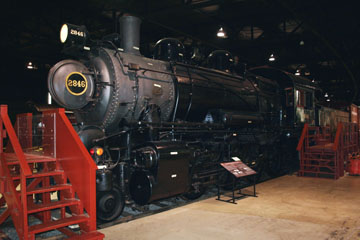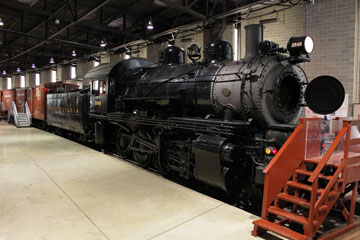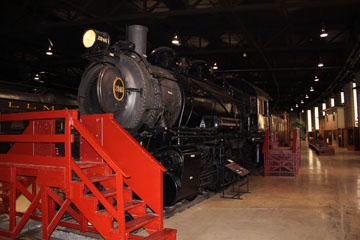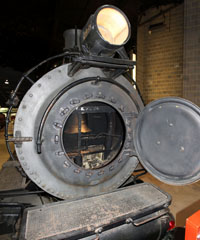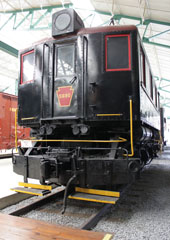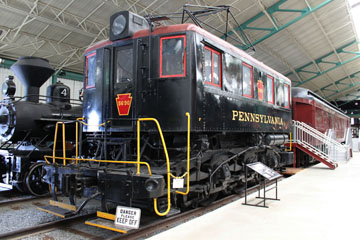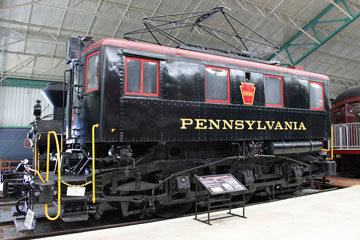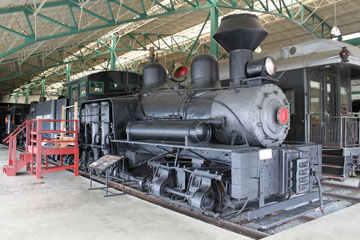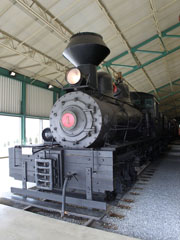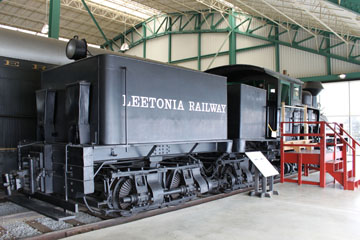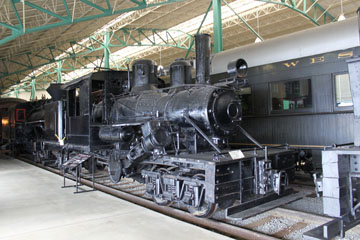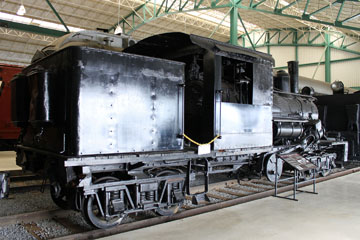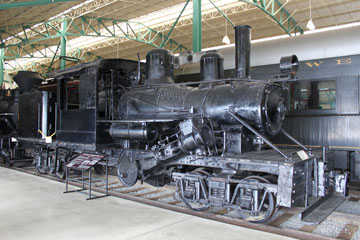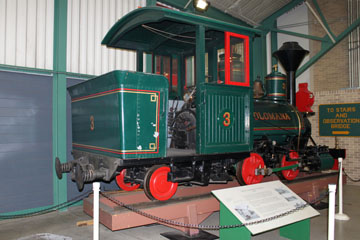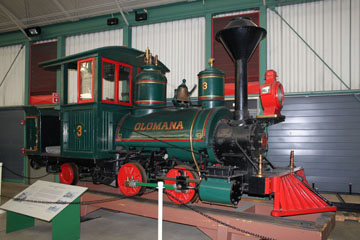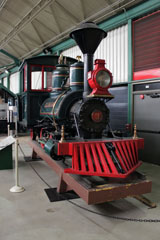

The Railroad Museum of Pennsylvania was created to provide a historical account of railroading in Pennsylvania. It is administered by the Pennsylvania Historical and Museum Commission with support from the "Friends of the Railroad Museum".
There is a great deal in the collection so I have split it over two pages.
This page has equipment displayed in the main train shed. The Railroad Museum of Pennsylvania Yard page has photographs of the equipment displayed outdoors. I have been to the museum frequently since 2004 and the photos on this page are from various visits.


Above, a view of the newly designed entrance to the museum and gift shop, opened in 2007.
The museum is on Gap Road/Pennsylvania Highway 741, close to the town of Strasburg, PA, and is open Tues-Sat 9.00am-5.00pm and Sun 12.00pm-5.00pm. Just across the road, the Strasburg Rail Road offers steam rides between April and December (you can see photos of two of the locomotives under steam on the Strasburg Rail Road page of this website)
Most of the museum's collection comes from one started by the Pennsylvania Railroad. Over the years, the Pennsy saved a number of its steam locomotives, either for display or posterity, which it stored in its Northumberland, PA, engine house. With the State of Pennsylvania seeking to set up a railroad museum and Penn Central (PRR's successor) wanting to get rid of the collection in the late 1960s, the equipment was moved to a new museum site in Strasburg. However, negotiations with a bankrupt Penn Central went on until 1979 when a deal was finally reached to give the museum complete ownership.
The first display building opened in 1975 with an operating turntable from the Reading Company. In June 1995, a train shed addition opened, which doubled the size of the indoor display.

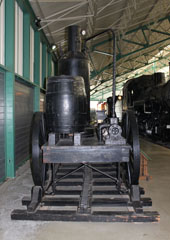
This replica steam carriage was built at PRR's Altoona work shops in 1939 for the 1939-40 New York World's Fair. Penn Central donated it to the museum in 1979.
The first US railroad charter was granted in 1815 to New Jersey lawyer, and inventor John Stevens and others for the New Jersey Railroad. He built the original steam carriage in 1825 and ran it on his Hoboken, NJ, estate with several passenger cars at 12 mph.
Another replica "John Stevens" is on the Museum of Science & Industry Chicago page of this website.

#94, a class A5s 0-4-0 switcher built at PRR's Juniata shops in 1917 (the "s" indicates a superheated locomotive), was a development of Pennsy's A class, which started in 1885 with the A1 and A2, formerly Q class. They were designed to work in industrial yards where tight movement was often required. The forty-seven A5s built from 1916 to 1924 were the last of the class.
#94 weighs 131,750 lbs, and has 50" drivers and
20" x 24" cylinders. It operated at a boiler
pressure of 185 psi, delivering tractive effort of 30,190 lbs.


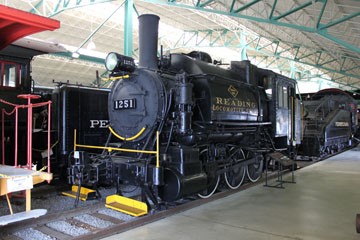
This 0-6-0T (Tank) locomotive was built at the Reading,PA, shops of the Philadelphia & Reading Railroad in 1918 from parts of a class I-2a Consolidation (2-8-0). It is typical of small yard switchers used across North America, although most had tenders.
Such conversions were quite common where railroads had their own locomotive shops and, in fact, the Reading shops outshopped over eight hundred and thirty locomotives between 1840 and 1948 although, of this output, only #1251 has survived.
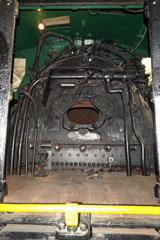
Above, a view from between the dual coal bunkers of #1251's backhead. The bunkers carried 2 tons of coal and the saddle tank 1,100 gallons of water.
This engine weighs 120,000 lbs and has 50" drivers and
20" x 24" cylinders. Operating at a boiler pressure of 150 psi, it delivered tractive effort of 24,500 lbs.
Apparently, #1251
was the sole saddle tank locomotive rostered by the Reading after WWI. It had a long life
working at the railroad's shops in Reading, PA.
Finally retired in 1963, #1251 was then the
only steam engine still in use on a US Class I railroad.
#1251 was bought by George Hart / Rail
Tours in 1964 and operated on the Pennsylvania & Maryland heritage railroad line in York, PA. It was paired with a former Reading tender for water supply and remained in service until 1966.
It was moved to the Railroad Museum of Pennsylvania in 1968, and was finally purchased outright in 1972. It was cosmetically restored in 1982.

Like many V&T engines, "Tahoe" underwent several modifications over the years. Originally a wood burner, it was converted to burn coal in 1907. Then, in 1911, it was converted to an oil burner. After over fifty years service hauling ore as well as passenger trains, it went into storage at Carson City, NV, in 1926.
In 1942, "Tahoe" was sold for $2,000 to Clifford C. Bong Construction, and it helped build several railroad classification yards for the US Army Corps of Engineers. After the war, it was stored in Bong's Arcadia, CA, yard.
Burnham, Parry, Williams & Company, an early incarnation of the Baldwin Locomotive Works in Philadelphia, PA, built this Mogul (2-6-0) type locomotive for the Virginia & Truckee Railroad in 1875. It was one of four of the type built at a cost of $9,976 each.
Weighing 82,300 lbs, 713,000 lbs on its 48¼"
drivers the "Tahoe" has 17" x 24" cylinders. With a 16.75 sq ft grate and 93 sq ft firebox, total heating surface was 985 sq ft and, operating at a boiler pressure of 150 psi, it delivered 16,495 lbs tractive effort.
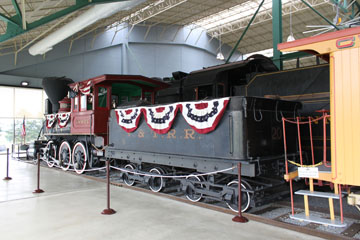
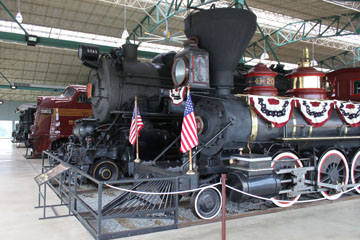
"Tahoe" was bought by the museum in 1968. It was shipped back to Strasburg where the Strasburg Railroad shops later restored it to roughly how it appeared when delivered in 1875.
Nine V&T locomotives are still in existence. You can see photos of VT #20 "Inyo" an American type (4-4-0) locomotive also built by Baldwin and delivered to the V&T in 1875, as well as VT #25 and VT #27 on the Nevada State Railroad Museum page of this website. VT #12 "Genoa" and VT #13 "Empire" are also on the California State Railroad Museum page.

Pennsy's Ten Wheeler (4-6-0) G5s class was designed by William F. Keisel, the railroad's Chief Engineer, for commuter service and needed speed, power and the ability to stop and start frequently. It was the most powerful ten-wheeler produced in the US and became the standard PRR commuter locomotive until superseded by diesels in the 1950s.
Ninety G5s class locomotives were built from 1923 to 1925 at Pennsy's Juniata work shop, and thirty more (classed G53) for the PRR subsidiary, the Long Island Railroad, from 1924 to 1929.
#5741 weighs 237,000 lbs, 178,000 lbs on its 68" drivers. The cylinders are 24" x 28". With a 55.2 sq ft grate and 177 sq ft firebox, the total heating surface is 3,468 sq ft, including 613 sq ft superheating (hence the "s" in G5s). The G5s were built with power reverse gear, but were hand fired throughout their long working lives. Operating at a boiler pressure of 205 psi, they delivered tractive effort of 41,328 lbs.
The tender weighs 176,000 lbs light and has a capacity of 7,800 gallons of water and 13 tons of coal.

#1670 is 64' 4" long and weighs 180,300 lbs. It has 22" x 24" cylinders and 56" drivers. A coal burner operating at a boiler pressure of 205 psi, it delivered 36,140 lbs tractive effort.
#1670 worked mainly in the Baltimore, MD, area. Although displaced by diesel switchers on the Pennsy from the 1940s, the B6sb locomotives didn't completely retire until 1957, and #1670 was one of the last on 15th October 1957. It then went to Northumberland, PA, to join PRR's historic locomotive collection and was initially loaned to the museum by Penn Central in 1969.
Introduced in 1902, the B6 class (0-6-0) switcher was one of the most successful locomotives produced by Pennsy's Juniata Shops. Seventy-nine had been built by 1913. Fifty-five B6a class locomotives followed between 1913 and 1914.
In 1916, the B6 class was updated with a Belpaire firebox, superheater and power reverse lever. Reclassified B6sb, two hundred and thirty-eight of the class were built between 1916 and 1926.

#4094-D switched coal hopper cars at the company's Hauto, PA, plant until 1969, when it moved to the museum.
By then, it was liveried in black and gold but, during restoration, the museum uncovered the original sky blue livery #4094-D sported at Pennsylvania Power & Light.
This very stylish 0-8-0F (Fireless) locomotive was built by the Heisler Locomotive Works in Erie, PA, for display at the New York World's Fair in 1940. It is one of twenty-eight geared fireless locomotives built by Heisler from 1934 to 1941, and the largest fireless locomotive produced.
After the Fair, the locomotive was sold to the Hammermill Paper Company in Erie, PA, as #4 but its 190,000 lb weight proved to heavy for Hammermill's tracks. In 1941, it was therefore sold to the Pennsylvania Power & Light Company and renumbered #4094-D.

Above, a view of
#4094-D's cab. As the engine was powered by superheated steam pumped into the boiler from an external source, there was no need for a fire box or fire door.
#4094-D has 48" drivers and 30" x 28" cylinders. At a maximum boiler pressure of 350 psi, it could deliver 31,500 lbs tractive effort.
You can see fireless Bethlehem Steel #111 on this page, as well as PEPCO #43 on the B&O Museum Roundhouse page of this website.

Built in 1902 by PRR as #8063, an E2a class Atlantic (4-4-2) type, this locomotive was later converted to an E7s and renumbered #7002. It then represented the locomotive at the 1939-40 New York World's Fair that set a 127.1 mph steam locomotive speed record in 1905.
The record was set by the original #7002 between AY Tower and Elida, OH, on 12th June 1905 on its inaugural New York to Chicago run hauling the Broadway Limited. However, that locomotive, also built in 1902, had been scrapped in 1934.
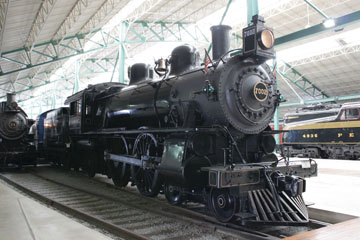
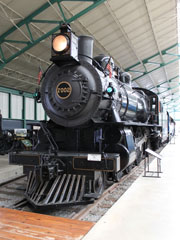
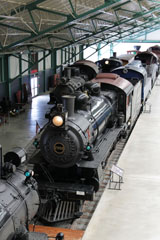
The E7s was a rebuild of the E2 and its sub classes, incorporating superheating. The original #7002 was one of eighty-two of the E2 class built from 1901 to 1902, followed by ninety-three of the E2a class (including #8063) from 1902 to 1905, seventy E2b versions built by both PRR and Alco, twenty-two E2c Alco built slide valve locomotives, then thirty-two E2d locomotives.
The “new” #7002 weighs 191,000 lbs, 121,000 on its 80” drivers. A coal burner, it has 22½” x 26” cylinders and, operating at a boiler pressure of 205 psi, it delivered 28,670 lbs tractive effort.

#1223 was built in 1905. The engine wheelbase is 22' 9" and the driver wheelbase 7' 8". The locomotive weighs 142,100 lbs, 98,150 lbs on its 68" drivers. It has Stephenson valve gear and
22½" x 26" cylinders. A coal burner, with a 33.2 sq ft grate and 181 sq ft firebox, total heating surface is 1,653 sq ft, including 253 sq ft superheating. It operated at a boiler pressure of 175 psi, delivering 23,902 lbs tractive effort.
The tender weighs 138,900 light, and has a
capacity of 5,600 gallons of water and 13 tons of coal.
#1223 is a classic American type locomotive
(4-4-0), the country's standard passenger locomotive for much of the 19th Century: by the 1870s, some 85% of all locomotives operating in the US were 4-4-0s.
The Pennsy remained committed to the American type well after most other railroads had
abandoned it in favour of larger, Atlantic (4-4-2) and Ten Wheeler (4-6-0) types. The D16 class, four hundred and twenty-nine of which were built at
the railroad's Altoona, PA, works between 1895
and 1910, were the most "modern" of PRR's Americans.
Two versions were designed to cope with
different terrain: a 68" drivered version (D16) for hilly country, and an 80" drivered version (D16a)
for flat terrain. Two hundred and sixty-two of a slightly changed 68" drivered version were built from 1900 to 1908, which became the D16b class. From 1914, PRR installed superheaters in two hundred and forty-one D16 locomotives, along with piston valves, increasing tractive effort. The 68" drivered locomotives were designated D16sb, and the 80" drivered D16sd (the "s" stood for superheated).
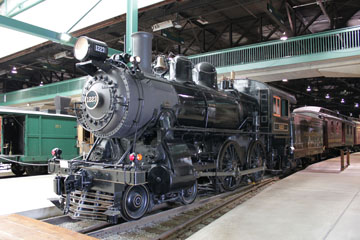

In service until 1950 hauling passenger trains in Maryland, Delaware and New Jersey, #1223 also featured in a number of films, including Broadway Limited in 1939 and Hello Dolly in 1968.
In 1960, #1223 was leased to the Strasburg Rail Road by the Pennsy, an arrangement repeated by its successor Penn Central and then by the Railroad Museum of Pennsylvania. The Strasburg returned it to operating condition, and it hauled tourist trains until 1989 when it was finally moved to the museum where it has been on static display ever since.

The Reading ran electrified commuter lines out of Reading Terminal in downtown Philadelphia, PA. It bought one hundred cars from 1929 to 1932 for service on these lines. They operated singly or as multiple-unit trains allowing the Reading to cope with the varying numbers of commuters depending on the time of day, week or year.
Delivered in 1932, #800 has two four wheeled trucks powered by two Westinghouse 423 motors delivering 600 hp. Constructed of steel and drawing power through an overhead pantograph, it is 73' long, 15½' tall and weighs 129,000 lbs.
This multiple unit rapid transit car, Reading EPa #800, was built by the Wilmington, DE, company Harlan & Hollingsworth in 1931.
Harlan & Hollingsworth dates back to the early 19th Century, building and repairing rail passenger and freight cars. In 1843, it became one of the first iron ship building yards in the US and, by the 1860s, had become the busiest in the country. It was acquired by Bethlehem Steel in 1904 and, although ship building then became more sporadic, the works continued to build rail cars until 1940, and parts for rail cars until 1944.

In 1928, #20 was sold to the Pennsy and renumbered #4738. Three years later, it went to
the Artemus & Jellico Railroad in Kentucky.
After ten years, it was then sold to the Buffalo Creek & Gauley and ran as #A in West Virginia. It finally returned to Pennsylvania in 1967 when the Lewisburg, Milton & Watsontown Passenger Railway Association bought it for preservation.
Two years later it was bought by the Strasburg Railroad, which renovated the car in 1977. Used occasionally for excursions until 1983, it was finally donated to the museum in 2002.
Built in 1921, #20 is a combined J. G. Brill carbody and 64 hp Mack Model AC 4 diesel bus engine. With capacity for thirty passengers, it is a typical "doodlebug", small self-propelled passenger cars that met the needs of shortlines across the US. As well as passengers, they often carried mail and parcels. Thirteen were built by Brill/Mack. #20 is just over 34½' and weighs 20,000 lbs.
It was bought by the Lewisburg, Milton and Waterstown Passenger Railway and ran on a Pennsy branch line between Montandon, Lewisburg and Mifflinburg, PA.

#1187 was outshopped in 1888 at a cost of $8,644. In 1913, it was sold to the J. T. Dwyer Quarry in Monocacy, PA, where it worked for another twenty-six years before being reacquired by the Pennsy in 1939. It was then restored to its 1888 appearance for display at the 1939-40 New York World's Fair as PRR's oldest surviving locomotive.
After the fair, #1187 went into storage at PRR's East Trenton, NJ, engine house and later joined the historic collection in Northumberland, PA.
This Consolidation type (2-8-0) locomotive was one of eight hundred and ninety class R locomotives built at the Altoona shops between 1885 and 1897. Later designated class H3, they were the Pennsylvania Railroad's primary freight hauling locomotive at the time and the first to use the square topped Belpaire firebox. This square topped firebox became standard on most Pennsy steam locomotives thereafter.
Various subsequent modifications to crown sheets, boiler pressure and stroke created additional classes H3a, H3b and H3c.
#1187 joined the museum collection along with the other PRR equipment from Northumberland in 1969 on loan. Only when the process of winding up the Penn Central was complete in 1979 was outright ownership transferred.
#1187 weighs 114,625 lbs, 100,600 on its 50" drivers. With 20" x 24" cylinders, a 31.1 sq ft grate, 166.8 sq ft firebox and total heating surface of 1,731 sq ft, it operated at a boiler pressure of 140 psi delivering 22,848 lbs tractive effort.
#1187 is displayed raised above a shallow pit, so that you can inspect the under side.

The Pennsy was allowed to borrow the locomotive over the following years but, by 1939, as the railroad prepared for the 1939-40 New York World's Fair, it was clear the "John Bull" was too precious for continued operation, so the Juniata works at Altoona, PA, produced this replica.
Other than a modern welded boiler and the
addition of a small injector, the replica exactly reproduced the original. Outshopped in
November or early December 1939, it made daily appearances at the fair as part of the "Pageant of Locomotives".
This is a replica of the 1831 "John Bull" built by Robert Stephenson & Co., of Newcastle in the United Kingdom and then shipped in parts to Philadelphia to work on the Camden & Amboy Railroad.
The home of the original "John Bull", the Camden & Amboy, was absorbed by the PRR in 1871 but, seeing the publicity opportunity of owning the oldest steam locomotive in the US, the Pennsy displayed "John Bull" at various fairs and expositions until gifting it to the Smithsonian in Washington DC in 1884 (you can see the original "John Bull" on the Smithsonian page of this website).
Work to restore the replica locomotive to working order began in 1982. Bolts and safety valves had to be replaced, and a water gauge and second injector had to be added. The use of a “bonnet” stack on the original “John Bull” was also identified and installed the night before the replica steamed up in May 1983 (the original in the Smithsonian has a later, serrated stack).
The replica has steamed within the museum, as well as on the neighbouring Strasburg Rail Road. It appeared at the Great Steam Expo in Vancouver, part of Canada's 1986 World's Fair.
Following the fair, the locomotive went into
storage along with the rest of the Pennsy collection, although it made a number of public appearances, for example, in PRR's 1942 promotional film Clear Track Ahead and at the 1948-49 Chicago Railroad Fair.
When obtained by the museum, the replica had deteriorated badly and much work was required before it could go on display in 1976. It is coupled to Camden & Amboy coach No. 3. Built in 1836, this is the second oldest passenger coach in the US and is on loan from the Smithsonian.
It joined many other famous operating locomotives to steam on several days at Railfair '99 at the California State Railroad Museum. In 1999, it also steamed at the Altoona Railroaders Memorial Museum, Steamtown and the Railroad Museum of Pennsylvania. Apparently, the replica rode much like the original and is surprisingly powerful for its size.
Since 2008, however, the replica’s boiler has not been certified as operational and it appears unlikely, without a further injection of funding, that it will steam again.


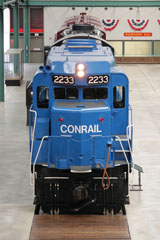
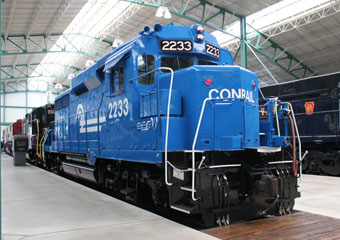
#2233 was one of fifty-two 2,250 hp GP30s ordered by the Pennsy and delivered by EMD in 1963.
Conceived to head off competition from GE's U25B, at 2,500 hp then the highest hp four axle diesel-electric in the US, the GP30 updated elements of the GP20 but managed to get an extra 250 hp out of the 567 series engine. Powered by a V16 EMD 567D3, the GP30 could deliver 50,000 lbs tractive effort at 9.3 mph and had a top speed of 65 mph. At 56' 2" in length, it weighs 253,000 lbs.
After spending eight years as part of Penn Central's fleet of sixty-two GP30s, #2233 joined the eighty-two strong Conrail GP30 roster in 1976. Most of Conrail's GP30s were retired within the next ten years, and #2233 was sold to the West Shore Railroad in 1985.
There, restored to its original PRR Brunswick Green livery, it hauled excursion trains and occasional freight trains until being donated to the museum in 1998. In 2002, #2233 was sent to the Norfolk Southern shops at Altoona to be returned to its Conrail livery.
Although it lost a little to the GE and Alco competition, the solidity and reliability of the GP30, helped by railroad mechanical departments' familiarity with EMD products, successfully countered the GE threat and maintained EMD's dominance in the market.
Nine hundred and eight GP30s were delivered between 1961 and 1963, all for US railroads. Forty cabless B units were also built for the Union Pacific, and two additional cab units were built by General Motors Diesel (GMD) in London, Ontario for the Canadian Pacific.

The GP9 was one of the most successful diesel-electrics ever: four thousand, two hundred and eighty units were built between 1954 and 1963, including forty B-units for the PRR and one hundred and twenty-five for the Union Pacific.
Three thousand, four hundred and forty-four units were built for US railroads, six hundred and forty-six for Canadian, ten for Mexican, five for a railroad in Brazil, four for a railroad in Peru and six for a railroad in Venezuela. Many rebuilt GP9s still operate with shortline railroads and industrial operators.
The PRR took delivery of sixty-six EMD GP7s from 1951 to 1955, and was convinced by their versatility and low maintenance costs that diesel locomotives were the motive power of the future.
Delivered in 1955, #7006 was part of an order of three hundred and ten GP9s that spelled the end of steam on the railroad: within two years, the last steam locomotive ceased operation. PRR's GP9s had a long life, operating well into the 1980s under Penn Central and Conrail. #7006 was gifted to the museum in 1985 and was repainted in its original PRR livery at Altoona in 2002.
Left, one side of #7006 is open showing the internals. An EMD 567C prime mover powered a GM D12B generator to drive four GM D-37 traction motors. Weighing 240,000 lbs and 56.5' long, they delivered starting tractive effort of 62,750 lbs at 25% and 40,000 lbs continuous tractive effort at 9.3 mph with a top speed of 65 mph.
You can see NW GP9 #521 and NKP GP9 #532 on the Virginia Museum of Transportation page of this website, NW GP9 #620 on the North Carolina Museum of Transportation page and BO GP9 #6607 on the B&O Railroad Museum Yard page.

#5900 and #5901 were delivered in 1945 for the South Wind, a joint PRR/L&N/ACL Chicago-Miami service. As the L&N and ACL used EMD diesel power, PRR was obliged to provide compatible locomotives for this joint venture, but a last-minute disagreement caused PRR to withdraw from the pooled-locomotive arrangement, leaving the two units without a regular work assignment.
Sent to Harrisburg, PA, until a permanent road assignment could be found, they were relegated to the GG1 service pit and treated much like any other pair of electric locomotives.
PRR #5901 is an EMD E7 with the classic rounded "bulldog" nose of the EMD E series. It is powered by two EMD 567A 12 cylinder prime movers powering two GM D4 generators to drive four GM D7 traction motors. It delivered starting tractive effort of 56,500 lbs at 25%, 31,000 lbs continuous at 11 mph with a top speed of 85 mph.
Four hundred and twenty-eight E7 A units were built and eighty-two cabless B units from 1945 to 1949, the most numerous passenger diesel locomotive ever built. In all, twenty-eight railroads rostered the model, but #5901 is the sole survivor.
Eventually, they were assigned to one leg of the Harrisburg-Detroit Red Arrow but, since it would take several weeks to establish a fuelling facility at Mansfield, OH, mid-way on the five hundred and seventy-five mile run, #5900 and #5901 were given random interim assignments on passenger runs between Harrisburg and Altoona, PA.
Once the new fuelling facility was in place, the two E7s began their new assignment and, eventually, made PRR history: after six months, they had together travelled more than 69,000 miles without a single road failure.

The look of the E-44 is somewhat stolid, with a boxy carbody similar to contemporary diesel designs but with the cab roof lowered to accommodate the pantograph.
The ends are also slightly bevelled, which imparts a slightly awkward dynamic.
#4465 was the last of sixty-six electric locomotives built by GE for the Pennsy from 1960 to 1963, and the last electric delivered to the PRR.
The design was based on the 33,000 hp ex-VGN EL-C class (you can see VGN EL-C #135 on the Virginia Museum of Transportation page of this website). They were powered by a water-cooled ignitron rectifier, an electron cylinder filled with mercury through which an AC current was passed to produce DC pulses. Designed to haul freight, they replaced Pennsy's aging P5 class electrics that were built between 1931 and 1933.
Apparently, crews referred to them as "bricks".
The E-44s transferred to Penn Central and Conrail but, when the latter ended electrified freight services in 1980, most were scrapped. Eight were sold to New Jersey Transit (#4458-#4465) and sat in storage for five years. They next saw life as maintenance of way engines for Amtrak on the Northeast corridor, but were soon retired because of age and concerns about the PCBs used in their transformers. The museum arranged to preserve #4465 in 1991 and it was returned to its PRR livery in 1997 at Conrail's Juniata shops.
The last six E-44s, including #4465, were equipped with silicon cooled rectifiers. Previous E-44 units had water cooled rectifiers, and the improved coolers boosted power from 44,000 hp to 50,000 hp. This new design was so successful, a number of earlier units were converted and reclassified as E-44a locomotives.
The E-44 weighs 384,260 lbs and is 69' 6" in length. It took an 11,000 volt AC current from an overhead catenary line, and its two 3-axle trucks could deliver maximum continuous tractive effort of 89,000 lbs with a top speed of 70 mph.

#4935 was one of the last GG1s built by PRR in 1943 (you can see the prototype, GG1 #4800 "Old Rivets" on the Pennsylvania Railroad Museum
Yard page of this website). They were introduced as part of Pennsy's massive 1930s electrification project, aimed at moving more trains with greater consists and faster acceleration than steam locomotives.
The overhead catenary was partly financed by low interest loans from the Federal Government as an economic stimulus during the Great Depression and is still used by Amtrak's Acela service today.
As the GG1 was designed to haul passenger trains, it also has a boiler that burned oil to produce steam to heat the passenger cars.
As part of the streamlining, the bell is hidden underneath the streamlined cowling.
The GG1s were very good at hauling heavy loads, largely because of a strong steel frame with added weight from concrete to facilitate traction.
When the Pennsy merged with New York Central in 1968, the GG1s was acquired by Penn Central. That railroad went bankrupt in 1970 and its freight operations were taken over by the government-controlled Conrail, which continued to use the GG1s. Amtrak also inherited several GG1s when it was formed in 1971. While they still easily met the demands of the Northeast Corridor in the late 1970s, growing problems with frame cracks and increasing difficulty obtaining replacement parts led to their eventual retirement. After a service life of almost fifty years, the last three GG1s (#4877, #4879 and #4882) were retired by NJ Transit after a day of Newark-Matawan farewell trips in October 1983. You can see #4882 on the National New York Central Museum page of this website.
Following restoration in 1977, #4935 was dedicated at a ceremony at the Union Station in Washington, DC. It made its last revenue run on 10th December 1980, hauling the Silver Meteor service south out of New
York. It was donated to the museum by Russell Wilcox in 1983.
Fifteen GG1s have been preserved, although none is operational. As well as #4800 on the Pennsylvania Railroad Museum Yard page of this website, #4890 is on the National Railroad Museum page, #4903 is on the Museum of the American Railroad page and #4919 is on the Virginia Museum of Transportation page.

Bethlehem Steel's roots go back to 1857 when the Saucona Iron Company was first organised. During its early years, the company produced rails for the rapidly expanding railroads, as well as armour plating for the US Navy. During World War I and World War II, it was a major supplier of armor plate and ordnance to the US armed forces.
From the 1970s the company faced growing competition from mini-mills, smaller-scale operations that could sell steel at lower prices. The company ceased manufacture in Bethlehem in 1995 and was bankrupt by 2001.
Like Pennsylvania Power & Light #4094-D shown earlier on this page, #111 which worked at Bethlehem Steel's Bethlehem, PA, plant, is a Heisler built fireless locomotive. Outshopped in 1941, it is one of the last locomotives constructed by the company, which closed that same year.
The contract to build #111 was won by Heisler in competition with both the Vulcan Iron Works and H. K. Porter by offering the most modern design at the lowest cost. It included an all steel welded steam storage tank, Timkin roller bearings and Walschaert valve gear.
#111, also known as "Three Aces", weighs 84,000 lbs and has 31" drivers and 19" x 17" cylinders. It could deliver 11,880 lbs tractive effort at a maximum boiler pressure of 200 psi. It worked at the Bethlehem, PA, plant until about 1970, when it went into storage. In 1972, Bethlehem Steel donated it to the museum.
You can see other fireless locomotives on the B&O Museum Roundhouse page of this website, the North Carolina Transportation Museum, Virginia Museum of Transportation,and Savannah Roundhouse Railroad Museum pages.

The seventeen mile line along the Allegheny River ran from Coudersport to Port Allegany. Originally narrow gauge, the line was converted to standard gauge in 1889. Prospering during a lumber boom into the early 20th Century, the line slowly declined until 1964, when it was bought by the Wellsville, Addison & Galeton.
This snow plow operated on the line until damaged by an accident in 1945. It was donated to the museum by the Wellsville, Addison & Galeton in 1980.

#2846 is a Consolidation type locomotive (2-8-0), one of two thousand and twenty-nine of this type rostered by the Pennsy, all designated H class. Designed for heavy freight, the H class was built by Baldwin, Lima, Alco and PRR in a variety of configurations. You can see H10 #7688 on the Railroad Museum of Pennsylvania Yard page of this website.
#2846 was one of one hundred and six H6 class locomotives built by Baldwin in 1905. They weighed 200,700 lbs and were, at the time, amongst the largest locomotives in the US.
Above, a view of #2846's backhead. Below, #2846's smokebox is open. A set of steps allow you look inside and see the exhaust nozzle, exhaust stand, netting and petticoat pipe.
#2846 has a 49 sq ft grate area, 167 sq ft firebox and 2,663 sq ft heating surface, including 429 sq ft superheating,
In 1913, #2846 was the first Pennsylvania Railroad locomotive to be fitted with superheaters. Other, later modifications include the addition of a power reverse lever. A pipe from the steam dome to the pilot wheels on the fireman's side of the locomotive was also a relatively rare addition. It was used in winter to discharge steam over frozen points.
The original tender weighed 49,600 lbs light with a capacity of 28 tons of coal and 7,200 gallons of water. The current tender appears to be from an E class like E6s #460 shown on the Pennsylvania Railroad Museum Yard page of this website.
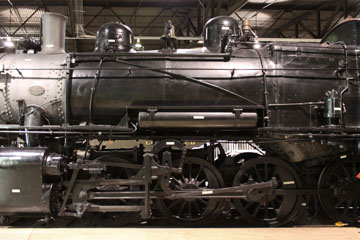
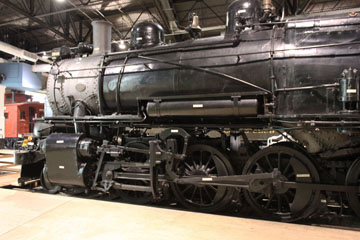
With an engine wheelbase of 24' 9" and driver wheelbase of 16' 6", #2846 weighs 198,600 lbs, 177,900 lbs on its 56" drivers. It has 23" x 28" cylinders, and operated at a slightly lower boiler pressure than the H6. Operating at 195 psi, it nevertheless delivered increased tractive effort of 43,841 lbs.
Not much is known about #2846's service life although it was certainly a long one. The engine was retired in 1956 and added to the Pennsy's collection in Northumberland, PA, before moving to the museum in 1969.

When PRR began electrification of the Northeastern corridor, it saw a need for compact electrified switchers for its coach yards, primarily in the New York and Philadelphia terminals, where passenger cars were inspected, serviced, cleaned and assembled.
In 1926, Pennsy began developing options with Westinghouse and jointly produced twenty-eight BB1 units. These operated as semi-permanently coupled pairs.
Fourteen of the B1 class followed. Although they operated in coupled pairs, each unit was also powerful enough to operate alone. They were
31' 6" in length, weighed 157,000 lbs and delivered tractive effort of 13,500 lb. Because of the way
they scuttled about the coach yards, they were rather unflatteringly christened "rats" by their train crews.
#5690 was one of the last B1s built, outshopped from the Juniata shops in 1934. It spent most of its working life in yards in and around New York. A continuing decline in passenger services in the 1950s and 1960s reduced the need for switching locomotives and most of the B1s were scrapped in the late 1950s.
Renumbered #4756 when Penn Central formed in 1968, this was one of the last B1s to operate on that railroad. Retired in 1971, #4756 was bought by the museum the following year. In 1973, it was restored to its original Pennsy livery and number.

Retired in 1964, the locomotive was bought by the museum in 1966 and restored to look like one of the Shays that operated on the Leetonia logging Railway in the Pine Creek area of Pennsylvania, although it never actually worked on the Leetonia.
The ten mile line connecting Leetonia with the New York Central at Tiadaghton through the rugged Pine Creek gorge had a relatively short life. Opened in 1899 it ceased operations in the early 1920s by which time most of the lumber had been milled out. None of the Shays that operated on the Leetonia has survived.
This 3-truck Shay was built by Lima in 1906 for Enterprise Lumber of Sims, LA, as #4. Like many lumber locomotives, it had a varied career, moving through different ownerships as lumber regions were clear felled and then abandoned.
In 1913, it was sold to Cherry River Boom & Lumber, Richwood, WV, as #16; in 1949 it went
to J. Natwick & Co., Alexander, WV; and in 1950 to F. C. Cook, Alexander, WV. In 1953 it was leased to Beech Mountain Railroad, Alexander, WV, and then in 1954 it was finally sold to Ely-Thomas Lumber in Fenwick, WV, where it worked as #2.
#1 weighs 110,00 lbs and has three 2" x 15" cylinders that power a drive shaft geared to the 36" drivers on the engineer's side. A wood burner, it operated at a boiler pressure of 200 psi and delivered tractive effort of 29,800 lb. The tender has a capacity of 3,000 gallons of water and 2.5 cords of wood or 5 tons of coal.
You can see other Shays on the Cass Scenic Rail Road page of this website, the North Carolina Museum of Transportation, the Travel Town page, the North Western Railroad Museum page and B&O Museum Roundhouse page.

Three classes of Climax were produced, two truck A and B, and three truck C class, the last a much heavier locomotive (there is a three truck Climax on the Southern California RLHS page of this website).
Between 1888 and 1928, the company produced 1,000-1,100 locomotives. They were designed to be powerful, agile and cheap, and the lighter models made them ideal for export: of the twenty or so surviving Climaxes, four are in New Zealand and two in Australia, where they worked for logging concerns.
#4 is another geared logging locomotive but of a slightly different design.
Built by the Climax Manufacturing Company of Corry, PA, instead of vertical cylinders and
pistons with a side drive shaft geared to the trucks as on the Shay, angled cylinders and pistons transferred drive to a central longitudinal shaft geared to the centre of each truck axle. This novel arrangement actually allowed for a two speed gear shift, with the lower gear providing higher tractive effort when the locomotive was hauling heavier loads.
#4 is a B class Climax, built in 1913 for Moore Keppel, a lumber company based in Ellamore, WV. It has 30" drivers and 11¾" x 12" cylinders. A coal burner weighing 80,000 lbs, it operated at a boiler pressure of 200 psi delivering tractive effort of 17,600 lbs.
#4 was sold to W. H. Mason Lumber, Elkins, WV, in 1948 where it worked for another 8 years before being sold to the Edaville Railroad, a heritage railroad then operating in South Palmer, MA. Edaville ceased operations in 1991 and #4 was sold to the museum the following year.

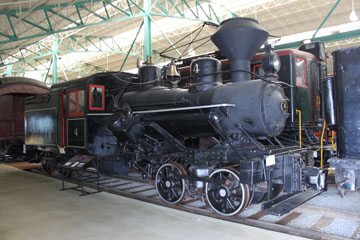

This 2 truck Heisler was built for W. T. Smith Lumber of Chapman, AL, in 1918 numbered #10.
This third major type of geared locomotive has
one cylinder set at 45° angles on each side of the boiler. The piston rods form a "V" connection to a central crankshaft that attaches to gears in an enclosed gear box on the furthest axle on each truck. Power was transferred to the other wheel on each truck by external connecting rods. The enclosed gear box made the Heisler better suited to mining and quarry work than other geared locomotives.
Between 1891 and 1941, the Dunkirk Engineering Company of Dunkirk, NY, the Stearns Manufacturing Company of Erie, PA, and finally the
Heisler Locomotive Works in Erie built six hundred and twenty-seven geared locomotives of this type. They were produced in both two truck and three truck models (there is a three truck Heisler on the Travel Town page of this website).
#4 was a coal burner. It
weighs 103,000 lbs, has 38" drivers and 15½" x 14" cylinders. Operating at a
boiler pressure of 180 psi, it delivered 24,160 lbs tractive effort. At some point, W. T. Smith sold it to the Angelina Hardwood Lumber Co., of Ferriday, LA, where it was renumbered #6. It then went to the Chicago Mill & Lumber Co., of Tallulah, LA, where it was renumbered #5.
Seeking to add examples of all the major Pennsylvania locomotive builders, the Pennsylvania Historical and Museum Commission bought #5 from Chicago Mill &
Lumber in 1965 for the museum. It was repainted as Heisler #4 before going on display.

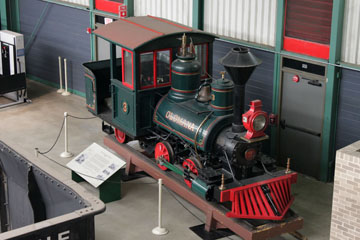

This narrow gauge (36") 0-4-2T (Tank) locomotive was built by Baldwin in 1883 for the Waimanolo Sugar Refinery in Waimanolo, on the island of Oahu, HI. It was shipped there from Philadelphia via Cape Horn and, when it arrived, was only the third steam locomotive in the Kingdom of Hawaii.
Initially named "Puaalii", in 1910 it was renamed "Olomana". #3 weighs 18,250 lbs and has 24" drivers and 7" x 10" cylinders. At a boiler pressure of 140 psi, it delivered 2,429 lbs tractive effort. #3 was used mainly to haul sugar cane from the fields to the refinery.
Between 1952 and 1953, it was converted to burn wood and restored to its original appearance by Best. The purchase and restoration cost Best $10,000.
In 1977, Best donated "Olomana" to the Smithsonian Institute in Washington, DC, , and it went on display at the Museum of American History.
It moved to the Railroad Museum of Pennsylvania in 1999 in what was meant to have been a
temporary arrangement before being moved to a permanent location near Allentown, PA.
In the fields, the engine ran on temporary track that was lifted and moved to new locations as the harvest proceeded. It ran at about 5 mph on this temporary track, but could reach 20 mph on the permanent rails at the refinery. Originally a coal burner, it was converted to burn oil in 1928. Dried cane was also tried, unsuccessfully, as a fuel. It was abandoned because it left a sticky residue inside the engine.
The locomotive was retired in 1944 and abandoned at the refinery. In 1948 it was bought by Jerry Best and shipped to San Gabriel, CA.
Related Links:
Railroad Museum of Pennsylvania Website
Strasburg Railroad Website
Pennsylvania Railroad Technical & Historical Society
Virginia & Truckee Railroad Website
Conrail Historical Society
Reference and Research Site for Shay Locomotives
Climax Locomotive History
Send a comment or query, or request permission to re-use an image.
Charles Swann Roberts wrote a comprehensive series on the history of PRR, Triumph I - Triumph IX, published by Barnard, Roberts and Co., between 1997 and 2008 (click on the cover to search for any of these books on Bookfinder.com).
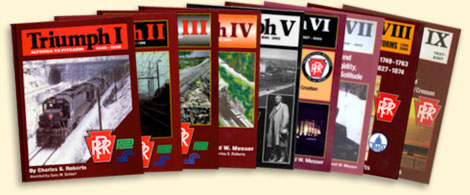
There is also a Pennsylvania Trail of History Guide to The Railroad Museum of Pennsylvania, published by Stackpole Books in 2002 (click on the cover to search for this book on Bookfinder.com).
